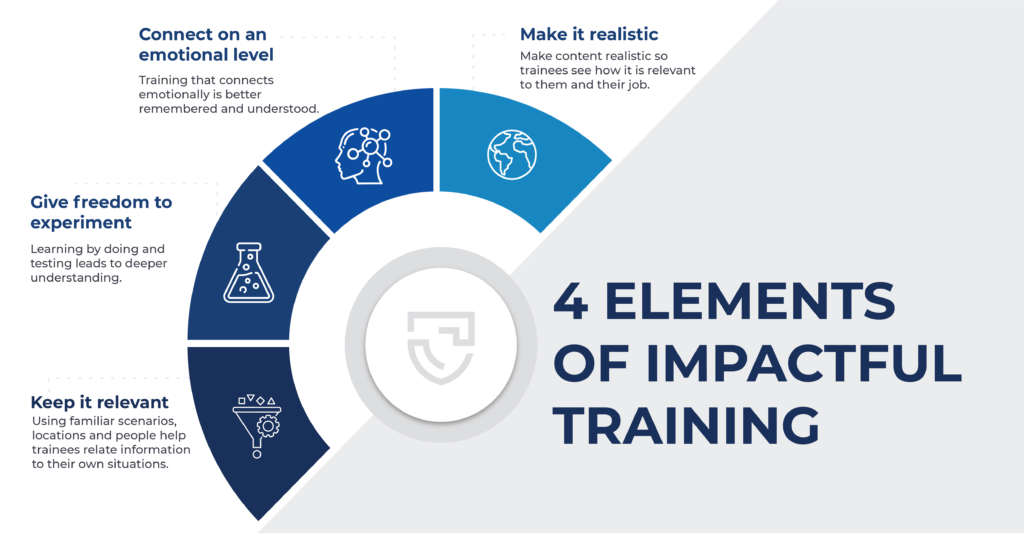
Many companies approach compliance and security awareness training as a mandatory, annual tick-the-box exercise. As you’ve probably experienced, this approach has little to no impact on actual learning.
To employees who have to do the training, it can feel like the aim of the programs is not to actually give you useful information, but to simply record that the company has told you “to not do this or that". Think back to your own experiences, when have you ever taken something away or learned anything from a boring “click next” training? Your employees are no different.
We have to engage first, if we want to have a chance of educating. It doesn’t matter if we have the best advice or content - If we can’t capture a learner’s attention and keep it, information won't stick.
What we know about how we learn
Think of a time you learned something new. Was this in a classroom, in corporate training, or in the real world? While we might spend a lot of time in classrooms or training workshops, most people build true understanding outside of these formal settings.
A useful guide is the 70:20:10 model[1]:
- 70% of learning comes from hands-on experience and addressing challenges
- 20% comes from working with others and social learning
- 10% comes from formal training and instruction
This highlights that it’s in the real world where we deepen and expand our knowledge, analyzing and synthesizing ideas. We learn by exploring, trying out different things and experiencing the consequences of our choices (good and bad). Reflecting on and remembering these experiences lets us reuse information and apply it to new contexts.
Make training engaging and effective
We’ve all sat through mind-numbing PowerPoint-style eLearning. Most of the time we end up tuning out. We focus our minds on something else while clicking “next” through a compliance quiz as quickly as we can.
It doesn’t have to be this way. Corporate training programs can be genuinely effective at helping employees learn necessary skills and behaviors to keep them, their colleagues and organizations safe and compliant.
Here I discuss four key levers we have to make training more effective, and share examples of what has worked well for us at SAME Solutions over the past years.

- Make it realistic
The point of training is to prepare employees for real world situations. So, it’s critical to make training as realistic as you can.
What has worked really well for us is putting learners into practical situations with Point of View training videos. They are immersed in the surroundings, making scenarios feel more like a realistic experience. We also add interactivity and branching scenarios, so learners see events unfold. Putting people into scenarios creates an "I have been here before" feeling that will help them to identify and navigate issues they might encounter in the real world. - Connect on an emotional level
People are ruled by their emotions, often without realizing. We pay more attention to information that makes us feel something, and we remember that information better.
The vast majority of our behavior is driven by automatic and impulsive reactions based on emotions and the subconscious[2]. Yet, most training speaks to the side of our brains that is rational, logical and puts in a lot of effort to assess situations. We use this side way less often.
So provide training scenarios that target learners’ emotional responses, rather than just their logical brain. This will make the information easier to remember and use when they’re in a similar real-life situation.
What has worked well for us is the use of cinematography techniques and trained actors to target learners’ emotions and get them to ‘feel’ about a situation, not just think about it. - Give freedom to experiment
Experimentation is a natural part of how we learn, and embracing curiosity is a great way to keep learners interested. Provide people with a safe environment to experiment and test their responses to challenging situations that they might face in the real world. Learning by doing means employees are deepening their understanding of concepts and internalizing the information.
We’ve found that interactive video scenarios are useful for learning by doing. In these scenarios, learners can test out different actions and get instant feedback. We try to make the best response not super obvious, and also encourage learners to try out clearly wrong options to see the consequences. This drives a lot of engagement because learners can see the immediate application and benefit of what they are learning. - Keep it relevant
If a learner gets overloaded with an endless amount of information and can’t see how this will apply to them, they won’t pay attention and won’t learn what they need to. Training should be cut back to what is absolutely essential to the individual. Less is more.
We took the approach of structuring training videos into shorter, more focused modules. This has worked well for us because learners can pick and choose what’s right for them. They are more likely to pay attention and gain relevant knowledge.
[1] You can learn more about the model at the Training Institute
[2] For more, see the book “Thinking, Fast and Slow” by Daniel Kahneman
